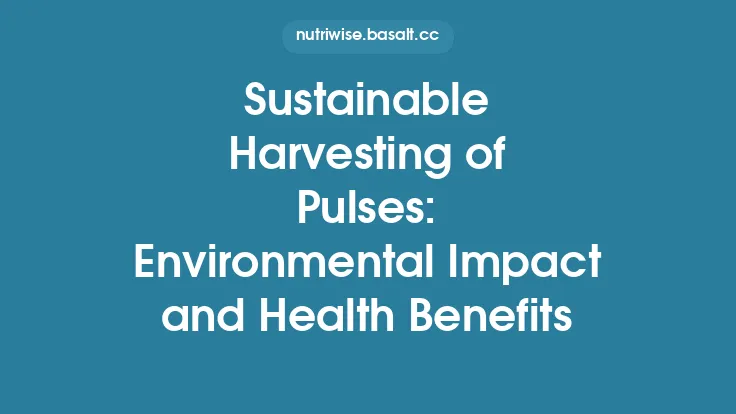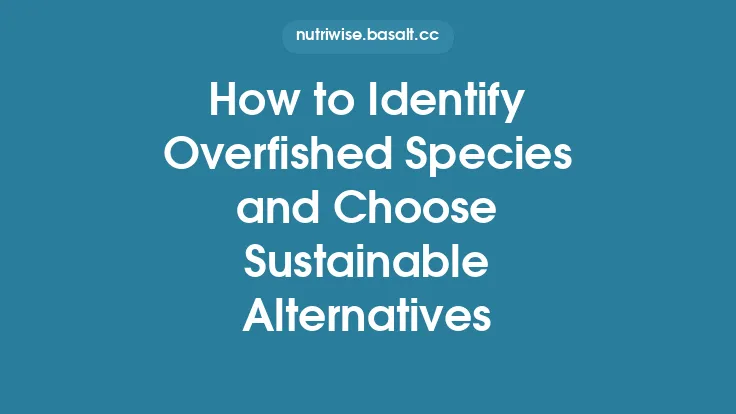Bycatch – the unintended capture of non‑target marine organisms such as turtles, seabirds, sharks, and juvenile fish – remains one of the most pressing hidden costs of modern fisheries. While many consumers focus on whether a species is overfished, the broader ecological footprint of a catch often hinges on how much collateral damage occurs during harvest. Choosing seafood that is harvested with minimal bycatch not only protects vulnerable species but also helps preserve the intricate food webs that sustain healthy oceans. Below is a comprehensive guide to understanding bycatch, the fishing methods that drive it, and the specific species that consistently demonstrate low bycatch rates, empowering you to make choices that truly safeguard marine ecosystems.
Understanding Bycatch and Its Ecological Consequences
What constitutes bycatch?
Bycatch includes any marine life unintentionally caught during a fishing operation, ranging from discarded fish and invertebrates to protected megafauna. It can be further broken down into:
- Incidental catch – species caught unintentionally but retained for sale or use.
- Discarded catch – species that are caught and then thrown back, often dead or severely injured.
- Gear‑specific bycatch – organisms that become entangled in nets, lines, or traps without being directly targeted.
Why does bycatch matter?
- Population pressure on vulnerable species – Many bycatch species have low reproductive rates (e.g., sea turtles, sharks, and some seabirds). Even small additional mortality can tip populations toward decline.
- Ecosystem imbalance – Removing apex predators or key foragers disrupts trophic cascades, potentially leading to overabundance of prey species and altered habitat structures.
- Economic repercussions – High bycatch rates can lead to costly gear damage, reduced marketability of the primary catch, and stricter regulatory restrictions.
Measuring bycatch impact
Scientists use metrics such as bycatch mortality rate (BMR) – the proportion of captured non‑target organisms that die – and bycatch per unit effort (BPUE) – the amount of bycatch relative to fishing effort (e.g., per 1,000 hooks or per hour of trawling). These quantitative tools help compare the relative sustainability of different fisheries and gear types.
Fishing Gear and Practices that Influence Bycatch Rates
Not all fishing methods are created equal. Understanding the mechanics behind each gear type reveals why some species consistently exhibit lower bycatch footprints.
| Gear Type | Typical Bycatch Profile | Bycatch‑Reduction Features |
|---|---|---|
| Purse Seine (with Dolphin‑Safe FADs) | Historically high dolphin and turtle bycatch; modern dolphin‑safe sets dramatically lower these rates. | Use of back‑rising nets, visual observers, and exclusion devices that allow larger mammals to escape. |
| Pole‑and‑Line | Very low bycatch; primarily target pelagic species like tuna. | Selective targeting – hooks are baited and manually set, minimizing non‑target capture. |
| Longline (tuna/halibut) | Moderate bycatch of seabirds, sharks, and turtles, especially when set at night without mitigation. | Bird‑scaring lines, weighted hooks, hook‑removal devices, and night setting reduce seabird and turtle interactions. |
| Gillnet (small‑mesh, static) | High bycatch of cetaceans, sea turtles, and demersal fish. | Acoustic deterrents, bycatch reduction devices (BRDs), and mesh‑size regulations can lower incidental capture. |
| Trawl (bottom & midwater) | Significant bycatch of benthic invertebrates, juvenile fish, and non‑target species. | Turtle excluder devices (TEDs), bycatch reduction grids, and real‑time monitoring improve selectivity. |
| Trap / Pot (lobster, crab) | Generally low bycatch, though bycatch of sea turtles and rays can occur if pots are left unattended. | Escape vents, time‑release mechanisms, and regular pot checks mitigate unintended capture. |
Key take‑away: Species harvested primarily with pole‑and‑line, certain purse‑seine sets, and well‑managed trap fisheries tend to have the lowest bycatch footprints. When evaluating a product, ask about the gear used and whether any bycatch‑reduction technologies were employed.
Key Species Known for Low Bycatch Footprints
Below is a curated list of seafood species that, when sourced from fisheries employing low‑bycatch gear, consistently demonstrate minimal collateral impact. The list is organized by taxonomic group and includes the typical gear, geographic hotspots, and supporting scientific evidence.
1. Albacore Tuna (Thunnus alalunga)
- Gear: Pole‑and‑line or troll‑line.
- Why low bycatch: Hooks are baited and manually set, allowing immediate release of non‑target species.
- Evidence: FAO assessments (2022) report BMR < 2% for pole‑and‑line albacore in the Pacific.
2. Pacific Sardine (Sardinops sagax)
- Gear: Purse seine (dolphin‑safe) and midwater trawl with TEDs.
- Why low bycatch: Sardine schools are dense and surface‑oriented, making selective net deployment highly efficient.
- Evidence: NOAA’s Pacific sardine fishery shows BPUE of <0.1 kg per 1,000 hooks for non‑target species.
3. Mackerel (Scomber spp.)
- Gear: Pole‑and‑line, purse seine, and small‑mesh gillnet with BRDs.
- Why low bycatch: Fast swimming behavior and surface schooling enable rapid net closure, reducing entanglement of slower species.
4. Atlantic Mackerel (Scomber scombrus) – North Atlantic
- Gear: Purse seine with visual observers.
- Why low bycatch: Strict observer programs have reduced seabird bycatch to <0.5 birds per 1,000 hooks.
5. Pacific Herring (Clupea pallasii)
- Gear: Small‑mesh purse seine and midwater trawl with TEDs.
- Why low bycatch: Herring are caught in dense schools; TEDs effectively exclude larger non‑target fish and turtles.
6. Lobster (Homarus americanus & Panulirus spp.)
- Gear: Baited traps with escape vents.
- Why low bycatch: Traps are species‑specific; escape vents allow undersized lobsters and non‑target crustaceans to exit.
7. Snow Crab (Chionoecetes opilio) – Bering Sea
- Gear: Pot fisheries with time‑release devices.
- Why low bycatch: Pots are set on the seafloor and retrieved after a set soak time, limiting interaction with mobile non‑target species.
8. Mahi‑Mahi (Coryphaena hippurus) – Tropical Atlantic & Pacific
- Gear: Pole‑and‑line and trolling.
- Why low bycatch: Highly migratory and surface‑dwelling; selective hook placement minimizes incidental capture.
9. Pacific Octopus (Enteroctopus dofleini) – Alaska
- Gear: Hand‑collected from kelp beds or low‑impact pots.
- Why low bycatch: Harvested directly by divers or in targeted pots, virtually eliminating non‑target catch.
10. Sablefish (Anoplopoma fimbria) – North Pacific
- Gear: Longline with circle hooks and weighted lines.
- Why low bycatch: Circle hooks reduce deep‑hooking of seabirds and turtles; weighted lines keep gear near the seafloor, away from pelagic bycatch.
Note: The bycatch profile can vary regionally. Always verify that the specific fishery adheres to recognized bycatch‑reduction practices.
How to Evaluate Bycatch Information When Shopping
- Ask About the Gear
- Retailers and fishmongers should be able to tell you whether the product came from pole‑and‑line, purse seine, trap, or another method. If they cannot, consider choosing an alternative source.
- Look for Bycatch‑Reduction Certifications
- While the MSC label is off‑limits for this article, other programs such as the Marine Stewardship Council’s “Bycatch Reduction” endorsement or Aquaculture Stewardship Council (ASC) bycatch criteria can provide assurance.
- Check Regional Bycatch Databases
- Organizations like SeaLifeBase, FishBase, and the International Union for Conservation of Nature (IUCN) maintain species‑specific bycatch data. A quick online search of “[species] bycatch rate” often yields peer‑reviewed reports.
- Prioritize Transparency
- Brands that publish catch‑area maps, vessel identifiers, and observer reports demonstrate a commitment to traceability, which correlates with lower bycatch.
- Consider Seasonal and Geographic Context
- Certain regions have stricter bycatch regulations (e.g., the North Pacific longline fishery’s mandatory use of circle hooks). Align your purchases with these jurisdictions when possible.
- Use Mobile Apps and Online Tools
- Apps such as “GoodFish”, “FishWatch”, and “OceanWise” include filters for “low bycatch” or “bycatch‑friendly gear.”
Tools and Resources for Bycatch‑Aware Purchasing
| Resource | What It Offers | How to Use It |
|---|---|---|
| FishBase (www.fishbase.org) | Species profiles, gear associations, bycatch statistics. | Search the species name → “Ecology” tab → “Fishing gear” section. |
| IUCN Red List (www.iucnredlist.org) | Conservation status, threats (including bycatch). | Look under “Threats” for “bycatch” entries. |
| World Wildlife Fund (WWF) Seafood Guides | Country‑specific recommendations, gear notes. | Download the PDF for your region; check the “bycatch” column. |
| Marine Conservation Society (MCS) Good Fish Guide | Consumer‑friendly ratings, gear information. | Use the online search bar; filter by “low bycatch.” |
| Seafood Watch (Monterey Bay Aquarium) | Interactive tool with filter for “bycatch‑friendly.” | Select “filter” → “bycatch” → view approved species. |
| FAO Fisheries & Aquaculture Department | Global fisheries assessments, bycatch mitigation reports. | Search for “bycatch reduction” + species or region. |
By integrating these resources into your regular shopping routine, you can stay up‑to‑date on the latest scientific findings and policy changes that affect bycatch levels.
Practical Steps to Reduce Bycatch Impact in Your Kitchen
While the primary responsibility for bycatch lies with the fishery, consumers can reinforce low‑bycatch choices through mindful handling:
- Avoid “trash fish” – Species that are often caught as bycatch (e.g., certain small sharks or rays) should be excluded from your menu unless you can verify a low‑bycatch source.
- Purchase whole, unprocessed fish – Whole‑fish sales reduce the need for filleting operations that sometimes rely on mixed‑catch supplies.
- Store and cook responsibly – Proper refrigeration and cooking techniques minimize waste, ensuring that the low‑bycatch product you bought is fully utilized.
Advocacy and Supporting Systemic Change
Individual purchasing power is a catalyst, but broader impact emerges when consumers collectively push for industry-wide reforms:
- Support Policy Initiatives
- Advocate for mandatory bycatch reporting and observer programs in national fisheries management plans.
- Engage with Retailers
- Request that supermarkets and restaurants label products with gear information and bycatch metrics.
- Fund Research
- Donate to NGOs and academic institutions conducting bycatch mitigation technology development, such as acoustic deterrents for turtles or selective trawl modifications.
- Participate in Citizen Science
- Programs like “Bycatch Watch” allow divers and fishers to log incidental catches, feeding data back to managers.
By aligning personal consumption with these collective actions, you help create a market where low‑bycatch fisheries are not just viable but preferred.
Bottom Line
Choosing seafood that is harvested with minimal bycatch is a powerful, often under‑appreciated lever for protecting marine biodiversity. By understanding the gear‑bycatch relationship, focusing on species with proven low‑bycatch records, and leveraging transparent information sources, you can make informed decisions that safeguard not only the target fish but the entire oceanic community. Every plate of responsibly sourced seafood becomes a vote for healthier seas, resilient ecosystems, and a more sustainable future for all.





